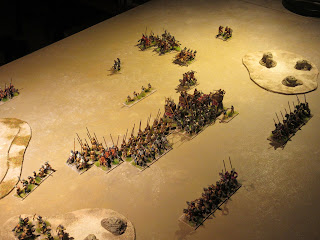Thursday, 24 October 2019
Early Egyptians vs. Nubian (3000 BC)
Tuesday, 15 October 2019
The Umayyad vs. the Abbasid
For these games, both armies of 24 elements are very similar in composition with a near equal proportion of cavalry to infantry. Both sides have trained cavalry, infantry and archers giving both sides an equal chance of victory.
Game one.
As defenders, the Umayyad deployed its infantry in centre with cavalry supporting the flank and rear. The Abbasid, deployed in a similar fashion, but had to contend with constricting terrain, The Abbasid had planned an evelopemnt with their right wing refusing their left. While the flanking move had its desired effect the cost to both sides negated any advantage won. The shattered remians on both sides reformed on their respective center. There, the conflict escalated to a blood bath with casualties becoming even each turn. Renewing their effort, the Umayyad however launced successive waves crumbling the Abbasid resistance to end the battle. Final score 9 - 5 for the Umayyad.
Game two.
Undeterred, the Abbasid gathered new forces to meet the Umayyad near Merv. Both sides formed their infantry in two wings with ample room for the employment of cavalry in the centre. These were positioned in a second line well outside of bow range.
On the Abbasid left, spearmen clashed with their counterpart while Zanj swordsmen destroyed enemy archers. The Abbasid joy was cut short as they lost a unit of their own on the opposite wing.
As the Abbasid were gaining ground on the left, their right was to suffer a similar loss against the Umayyad. As the struggle intensiified the Abbasid were able to turn events on their right to their advantage. Sensing the approach of tipping point in the battle, the Umayyad, commander launched a cavalry assault against the Abbasid centre.
Abbasid archers found their range and were scattering Umayyad cavalry in the centre and right flank. This opened an opportunity for Abbasid infantry to leave their secure position to attack exposed flanks. The subsequent casualties were the final blow for the Umayyad forcing them to flee the filed. Score 8 - 1 for the Abbasid.
The Umayyad
1 x general (Cv), 3 x Jund cavalry (Cv), 3 x spearmen (Sp), 2 x archers (3Bw), 1 x archer (Ps), 2 x Bedouin and Ghazis light horse (LH).
The Abbasid
1 x general (Cv), 3 x lancers (Cv), 3 x spearmen (Sp), 2 x archers (4Bw), 1 x Zanj (3Bd), 1 x archers (Ps), 1 x Bedouin light horse (LH).
The Umayyad were defending in game one, terrain features selected were from the list "Dry". This was 2 x rocky ground, an oasis and BUA (hamlet).
Monday, 14 October 2019
Enlarging the Standard Command.
The comments have been surprisingly favourable for the enlarged single command. Below are a list changes to the standard game.
The Game
Board
The game
board need only be increased by 50% when using this option. As an example, our
standard game board is 80cm x 80cm is now increased to 120cm x 80cm for this
option.
Terrain
Pieces.
The number
of terrain features for use with the BBDBA option are increased, but all our
tests found no reason to increase this for DBA24, for two reasons; larger
pieces could now be used and discarding pieces due to lack of space became a
rare occurrence.
Twice
the Number
DBA24
simply duplicates the number of elements forming a single command. For some
armies this will mean other options can now be used to bring the total number
of elements to 24. The Han Chinese as an example may field a mix of infantry
and cavalry or alternatively an all-mounted command.
Two Generals
Twice the
number of elements will also produce two generals. One is designated a CinC with
the second serving as a subordinate general. Although the loss of the subordinate
general counts as one element lost, his function is to extend the command distance
a further 8BW. If the CinC is lost during battle, the subordinate assumes
command of the army on the subsequent turn.
Allied
Contingents
If
employed, this too will double in size with a possible increase in the
diversity of troop type.
Demoralisation (01-05-2021)
Players familiar with DBA are aware that demoralisation of a command is a feature found only in the big battle option. Demoralisation is reached when it suffers a certain level of losses precipitating the flight its elements to an army’s base edge. The rule is particularly useful if playing medieval period scenarios that divide an army’s force into three ‘divisions’; van guard, main division and rear guard.
To
determine the ‘demoralisation’ for each ‘division’, calculate this as a third
of the division’s original elements, excluding horde and camp followers.
Reaching demoralisation, flight would take place on the player’s next turn.
Expending pips, a player can hold elements or groups in place with the process
repeating each turn. Victory is reached when 8 elements are lost or (new) if two
of the three divisions (vanguard, main battle or rear guard) are demoralised.
(see page 13, paragraph 7).
Additional Time Required to play?
Beginning DBA24 may require some adjustment as movement will seem slower than one is used to. The standard 12-element game, a decision can be reached on the 4th or 5th turn, but an extra two turns were all that was needed to declare a victor. Some games were resolved in 40 minutes needing seven turns while the longest required thirteen turns or 70 minutes to reach a decision.
Observations
The single
die cast to shift 24 elements required some rethinking as troops needed three
or four turns to move assault troops and supporting elements into striking
distance. What has worked successfully is following the ancient text books regarding
deployment, regrouping fragmented formations and the use of reserves.
Click on the Index to Storm Within the Empire, scroll to the bottom to
find Enlarging the Single Command to 24 elements which lists many examples of
battles.



























